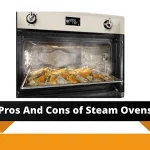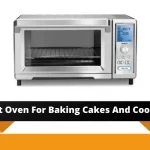Microwaves have quickly become a necessity in every home because they are convenient for heating food and don’t take up much time. However, one thing many people need to know about microwaves is that they need proper ventilation. This blog post will discuss why microwaves need ventilation and how you can provide it.
Microwaves do not typically need ventilation, as they are designed to be self-contained. However, if you are using your microwave to cook food, it is important to ensure that the food is cooked evenly by occasionally opening the door to let air circulate. Therefore Microwaves require ventilation as They require air to circulate around them in order to function properly and prevent overheating.
Why do microwaves need ventilation?
Table of Contents,
The main reason microwaves need ventilation is to keep them from overheating. When you use a microwave for a long time, it builds up heat that can cause the parts inside to overheat, making them less effective and possibly damaging. By giving your microwave enough airflow, you can help it stay at the right temperature and ensure it works correctly.
Ventilation is also important because microwaves can give off a small amount of radiation when they are in use. This radiation can be dangerous if you do not ventilate properly, so providing proper ventilation helps to keep your family safe and healthy.
Methods of Ventilation
Providing ventilation for your microwave is easy, and you can do it in a few different ways.
Install a Range Hood With An External Vent
The first way is to install a range hood with an external vent. It is the best way to vent your microwave because it eliminates all the steam and cooking smells in the kitchen. It also helps keep your kitchen clean and prevents any potential fire hazards because of a buildup of grease or gas.
Install a Charcoal Filter Inside The Microwave
The second way is to install a charcoal filter inside the microwave. It will help remove some steam, smoke, and odors from cooking in the microwave. It’s important to note that this option won’t eliminate all the steam, smoke, or odors but will help reduce them significantly.
Invest in a Microwave With A Built-In Venting System
The third way to ensure your microwave has enough air flow is to buy one with a built-in ventilation system. Many microwaves today come with this feature to help remove steam and odors while cooking. It is the most acceptable option, as you don’t have to worry about installing anything for it to work.
Countertop Microwave
Countertop microwaves are small, self-contained ovens that can be placed atop a kitchen counter. This microwave may not have the same power as traditional wall-mounted ovens. Most people prefer it because these microwave ovens offer tremendous convenience and flexibility with limited space or budget.
Do countertop microwaves need ventilation?
A convection countertop microwave must be vented to maintain airflow and prevent overheating. You can install an external vent or ducting system near the oven. However, if your countertop microwave is a standard microwave oven, you do not need to vent it. Some standard microwaves have a self-contained ventilation system and do not require additional ventilation.
In either case, correctly maintaining your countertop microwave is essential to ensuring its long-term performance and safety. Therefore, clean and maintain the microwave regularly according to the manufacturer’s instructions. It will ensure that your countertop microwave keeps working well for many years.
Drawer Microwaves
Drawer microwaves, also known as pull-down microwaves, are a modern and convenient alternative to traditional countertop microwaves. These microwaves are installed under the kitchen counter and pulled out like a drawer when needed. They typically offer more space than regular countertop models, making them ideal for high-capacity cooking.
Do drawer microwaves need ventilation?
In most cases, they do not need ventilation. Drawer microwaves are self-venting and require minimal installation from an electrician or contractor. These microwaves ventilate air through a filter on the top of the drawer, so you won’t have to worry about messy ductwork or extra ventilation systems. It’s always best to check with the manufacturer’s guidelines, as some brands may require additional venting.
With their sleek and discreet design, drawer microwaves are a great way to save space in your kitchen without sacrificing the convenience of a traditional microwave. So if you’re looking for an efficient and stylish cooking solution, consider getting one of these drawer ovens!
Mounted Microwave
Mounted microwaves or wall ovens are a great alternative to countertop models as we can install them directly into the wall. These microwaves come in different designs and sizes, so you can find one that perfectly fits your space and cooking needs. Mounted microwaves offer high power capability and easy access, making them an ideal choice for those with limited counter space.
Do mounted microwaves need to be vented?
It depends on what type of mounted microwave you have. Microwaves with convection mode require an external vent, but standard microwaves do not need to be vented. When using a convection-mounted microwave, install an external vent or ducting system to ensure that your oven performs at its best.
Over The Range Microwave
Over-the-range microwaves are handy kitchen appliances; they offer convenience and time-saving benefits. These powerful microwaves are designed to be mounted on a wall or above your stove, freeing up counter space and making it easy to access meals quickly. They also support features like convection cooking, auto cook settings, and sensor cooking, allowing you to prepare delicious meals in no time.
Do over-the-range microwaves need ventilation?
These microwaves do not need ventilation because of their design. Most over-the-range microwaves come with internal ventilation systems that draw air from inside your kitchen and re-circulate it outside. It means you don’t need to worry about exhausting air from your kitchen.
Before buying, you should check to make sure that the model you want has a built-in ventilation system. Some models may require external venting for optimal performance, so double-check the product specifications to find out.
Solo Ovens
Solo ovens, also known as single-chamber ovens, are a type of convection oven used in commercial and industrial applications. They provide a high-temperature control. Chefs often use these ovens for baking bread, pastries, and other foods.
How To Ventilate a Solo Oven?
Ventilation for solo ovens is a necessary factor in maximizing safety, performance, and energy efficiency. Proper ventilation exhausts the heat from the kitchen’s interior, reducing the risk of fire and heat-related accidents. Several methods to ventilate a solo oven include direct, natural, and mechanical ventilation.
- Direct ventilation: Direct venting is the most common method of ventilating a solo oven. This method connects the oven to an outside wall or chimney via piping that carries heated air outdoors. Direct venting helps keep hot air away from the kitchen and prevents heat buildup.
- Natural ventilation: Natural ventilation is another standard method of ventilating a solo oven. In this method, the kitchen has an open-air design that allows natural air circulation and encourages warm air to rise. Natural ventilation helps keep hot air away from the kitchen and reduces the risk of heat buildup.
- Mechanical ventilation: Mechanical ventilation is a more complex method of ventilating a solo oven. This method connects the oven to an external fan or ventilation system that draws hot air out of the kitchen and sends it outdoors. Mechanical ventilation helps keep hot air away from the kitchen and reduces heat buildup.
Also, Read Trending Topics
FAQs
It’s recommended to vent your microwave at least once a year. It ensures the appliance gets plenty of fresh air and keeps running at its best. Additionally, it may be time to vent the appliance if you start noticing any strange smells coming from your microwave when it’s in use.
By ventilating your microwave, you keep dust, dirt, and other particles from building up inside it. Ventilation keeps your microwave clean and helps it run more efficiently and safely. Additionally, venting your microwave will help keep the appliance’s temperature safe, preventing unnecessary wear and tear on the internal components.
If you start noticing any strange smells coming from your microwave when it’s in use, or if the appliance takes a long time to heat food, it may be time to vent your microwave. Additionally, if you hear strange noises from the appliance when used, it could also be a sign that your microwave needs ventilation. Finally, if the buttons on your microwave suddenly become harder to press, this is a sign that it needs to be vented.
You can use a soaked cloth to wipe away any dust or dirt from the ventilation area of your microwave. If you have access to a vacuum cleaner with an attachment hose, this is also an effective method for cleaning the area. Be careful when cleaning your microwave, and avoid using harsh chemicals or scrub brushes that could damage the internal components. Finally, unplug your microwave before doing any cleaning or maintenance work. Doing this will ensure your safety and the safety of your appliance.








